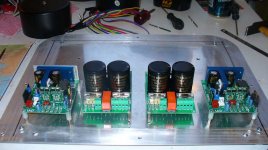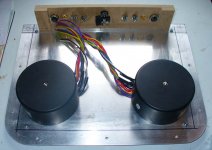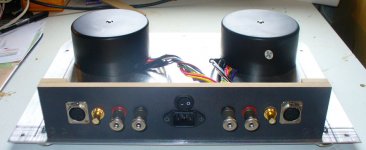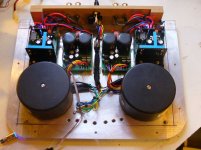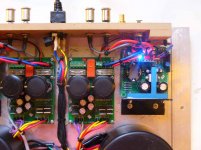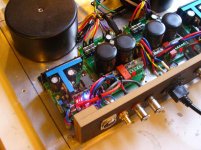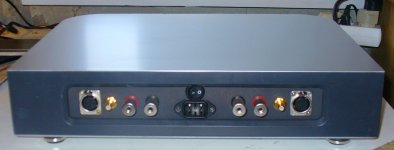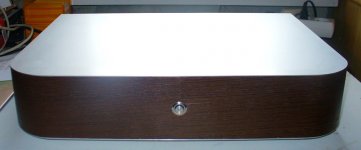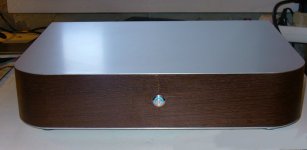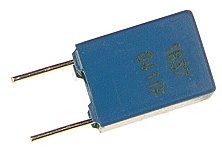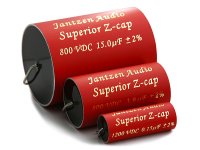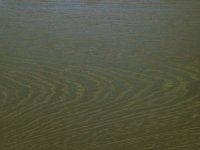Hi all,
After more then 3 years of (satisfying) listening with a pair of UcD400AD, I decided to build a brand new amp, with parts 100% supplied from Hypex.
Just want to share some pics, and some comments.
No I have brand new, totally unmodified UcD400HG, with HpR and HnR, HG mon psu and the 400VA trannies.
Will post the pics one by one.
Cheers,
- Dan
After more then 3 years of (satisfying) listening with a pair of UcD400AD, I decided to build a brand new amp, with parts 100% supplied from Hypex.
Just want to share some pics, and some comments.
No I have brand new, totally unmodified UcD400HG, with HpR and HnR, HG mon psu and the 400VA trannies.
Will post the pics one by one.
Cheers,
- Dan
Attachments
Ucd400 amp finished
My "old" UcD400 was powered by a home made PSU, using HFA08TB60 diodes from Schuro in Germany, and Cerafine 10.000µF caps (4x for thge whole stereo amp). Some 1µF MKP caps bypassed the Cerafines, and 47nF the diodes.
At the beginning I wasn't happy with the coupling caps in the UcD modules, and bypassed them. From the the input XLR's I connected 2 Auricap 6µF caps per channel. This improvement was very noticable.
Since my (actual) preamp has some output caps, I put a switch which bypassed the Auricaps - so there were virtualy no coupling caps in my amp.
Thanks to DIYAUDIO.COM I changed the AD8620 to LM4562 which I bought in quantity at Mouser - paid more then 100 bucks, but sold most of them, and had a per unit price which is a half as what you can find them here in Europe - at least in 2007. Today, Schuro offers them for 5,36 € piece, which is less then half the AD8620 - foe a better sounding OpAmp.
That's where I stopped the mods, because the case became small, and the boards a little messed up. No changes of the filtercaps, or special regulation for the OpAmps. Also, the case was handmade and not exactly a beauty or well made.
My "old" UcD400 was powered by a home made PSU, using HFA08TB60 diodes from Schuro in Germany, and Cerafine 10.000µF caps (4x for thge whole stereo amp). Some 1µF MKP caps bypassed the Cerafines, and 47nF the diodes.
At the beginning I wasn't happy with the coupling caps in the UcD modules, and bypassed them. From the the input XLR's I connected 2 Auricap 6µF caps per channel. This improvement was very noticable.
Since my (actual) preamp has some output caps, I put a switch which bypassed the Auricaps - so there were virtualy no coupling caps in my amp.
Thanks to DIYAUDIO.COM I changed the AD8620 to LM4562 which I bought in quantity at Mouser - paid more then 100 bucks, but sold most of them, and had a per unit price which is a half as what you can find them here in Europe - at least in 2007. Today, Schuro offers them for 5,36 € piece, which is less then half the AD8620 - foe a better sounding OpAmp.
That's where I stopped the mods, because the case became small, and the boards a little messed up. No changes of the filtercaps, or special regulation for the OpAmps. Also, the case was handmade and not exactly a beauty or well made.
Attachments
The case for the new amp was made by a colleague and friend, Thomas, who is a very skilled designer, but also handyman.
The bottomplate is a alu plate in 4mm, the back panel MDF in various thicknesses, and painted in black.
All coonectors are screwed on the wood panel: Neutrick XLR connectors, some Teflon insulated goldplated RCA sockets, WBT connectors for the speaker output.
The bottomplate is a alu plate in 4mm, the back panel MDF in various thicknesses, and painted in black.
All coonectors are screwed on the wood panel: Neutrick XLR connectors, some Teflon insulated goldplated RCA sockets, WBT connectors for the speaker output.
Attachments
Here all components are mounted and wired. The flat wire which is going out to the front is the to connect the Mute switch, which is a circular blue Led type. You can see it on the left rounded corner; it's actually on. I put a connector, because this switch will be in the front panel (see some pics later).
Attachments
A detail of the modules: the UcD power amps are mounted with an alu corner, actuall not very thick (2.4mm) - I'll see if it's enough to tranfer the heat to the bottom alu plate, which should be enough to dissioate the calories (I'm not using the amp for partying...).
Wiring is very short, high quality speaker cable, and teflon insulated, silverplated single wires for the input, w/o shielding.
Wiring is very short, high quality speaker cable, and teflon insulated, silverplated single wires for the input, w/o shielding.
Attachments
nother view of the mounting and wiring. I didn't used the provided faston connectors, everything has been soldered with 4% silver solder; all wires ahev heatshrink tubes to make it look pretty neat.
Observe the red SMD Leds on the regulators, together with the blue Led on the UcD board - kind of weird color combination, but looks interesting. I might make some holes in the top plate in that area, if the amp heats up, and will make the lights easily being seen from outside.
Observe the red SMD Leds on the regulators, together with the blue Led on the UcD board - kind of weird color combination, but looks interesting. I might make some holes in the top plate in that area, if the amp heats up, and will make the lights easily being seen from outside.
Attachments
Now the cover is on, and the back looks clean and simple - no need to writ who is who.
As explained, the main switch is the one in the back (since I leave the amp on constantly, except when I'm on holidays or so).
The UcD modules have a mute function, which is been done by the front switch.
As explained, the main switch is the one in the back (since I leave the amp on constantly, except when I'm on holidays or so).
The UcD modules have a mute function, which is been done by the front switch.
Attachments
Front view of the amp: it's again wood (MDF), rounded and with a real Wenge wood veneer. Top plate is an anodised alu plate. It's simple and very classy.
The switch is off here. Actually it's broken... it was an on/off switch, but my iron heatd it probably up too much, now it doesn't work anymore. It became a pushbutton. I have to change it (see if my supplier will replace it, for 8 € each he can do this!!)
The switch is off here. Actually it's broken... it was an on/off switch, but my iron heatd it probably up too much, now it doesn't work anymore. It became a pushbutton. I have to change it (see if my supplier will replace it, for 8 € each he can do this!!)
Attachments
this is the same pic, but the LED in the switch powered - it needs 24 volts! Which I'm taking from the additional +/-12V supply on the Hypex HG mone PSU.
Some parts, such as the feets, connectors, and the circular LED switch came from Audiophonics.fr, who also can provide the Hypex modules. They have nice cases too, but not as mine!
Some parts, such as the feets, connectors, and the circular LED switch came from Audiophonics.fr, who also can provide the Hypex modules. They have nice cases too, but not as mine!
Attachments
So, how does it sound?
It's too early to say, it need some time to burn in.
After 24 hours I can say that I don't regret to have changed: it seems to be relaxed, and more room around the instruments.
Actually, high frequencies are a little metallic, and not so natural (maybe even slightly recessed?).
I guess it comes from the coupling caps, which are Panasonic polyester or so.
In a week, when the amp has been "aged" a little I'll make a first trial: bypassing the 680nF (which are C36 and C37 on the UcD400HG, and C1 and C2 on the UcD180) withe the "magical" Vishay Roederstein MKP1837.
It's too early to say, it need some time to burn in.
After 24 hours I can say that I don't regret to have changed: it seems to be relaxed, and more room around the instruments.
Actually, high frequencies are a little metallic, and not so natural (maybe even slightly recessed?).
I guess it comes from the coupling caps, which are Panasonic polyester or so.
In a week, when the amp has been "aged" a little I'll make a first trial: bypassing the 680nF (which are C36 and C37 on the UcD400HG, and C1 and C2 on the UcD180) withe the "magical" Vishay Roederstein MKP1837.
Attachments
If the combi Panasonic / Roederstein isn't enough, I replace them with Jantzen Audio Superior Z (or even Silver Z) caps, one of the finest caps on the planet. Beat even the so praised silver/ gold stuff from Mundorf.
Since I mounted the modules in a way that some caps may be mounted from below, even 0.68µF will fit easily.
Promiss, I'll make a complete report soon, and again compare them to Halcro DM88 we have at work (search and see my post from last year or so).
Cheers
- Dan
Since I mounted the modules in a way that some caps may be mounted from below, even 0.68µF will fit easily.
Promiss, I'll make a complete report soon, and again compare them to Halcro DM88 we have at work (search and see my post from last year or so).
Cheers
- Dan
Attachments
BTW, Wenge is an african wood, rather dark. On my case (or "in" my caseé), it's a natural veneer, with no varnish. Jsut some wood wax, and a lot of polishing with some special wool. Have to repeat this every 6 month or so, but that's how it looks like most natural.
Attachments
Member
Joined 2003
Thanks, Dcibel,
I tried to make it as clean as possible, but also in the matter of wiring to have the best possible and shortest way (and thus best possible sound).
The seam in the front centre is because my friend had no such long veneer sheets to do it in once. He preferred to have this seam in the front, as a special effect - at the beginning it's a little bit "shocking", but with the switch in place it's OK. Maybe I'll insert some chrome or stainless steel stripes later, if I couldn't get habit of it. But the case looks awsome, one in my rack.
Actually I was thinking of a softstart. The Hypex one allows to have only a pushbutton to switch one the whole amp, but it also costs 59 Euro... But since I leave the amp on most of the time, I have no problem with blown fuses (the amp's one is a 6.3T - OK, it's a little high value but I tested it, with a full short circuit at the secondary of the transformer, it blew away immediately).
Maybe later, I still have some space left.
Cheers,
- dan
I tried to make it as clean as possible, but also in the matter of wiring to have the best possible and shortest way (and thus best possible sound).
The seam in the front centre is because my friend had no such long veneer sheets to do it in once. He preferred to have this seam in the front, as a special effect - at the beginning it's a little bit "shocking", but with the switch in place it's OK. Maybe I'll insert some chrome or stainless steel stripes later, if I couldn't get habit of it. But the case looks awsome, one in my rack.
Actually I was thinking of a softstart. The Hypex one allows to have only a pushbutton to switch one the whole amp, but it also costs 59 Euro... But since I leave the amp on most of the time, I have no problem with blown fuses (the amp's one is a 6.3T - OK, it's a little high value but I tested it, with a full short circuit at the secondary of the transformer, it blew away immediately).
Maybe later, I still have some space left.
Cheers,
- dan
Hi
I don't know why you would be comparing coupling caps. It's purely subjective based on the individual and his particular gear, different in every case. Unwaiveringly superior is DC coupled, and that, would be the thing to comment on.
Since in your case, with your pre already AC coupled, it's really little use doing so again. There's just no "magic" combination of caps for all to try here. I have however found certain PPS caps for the input stage that are brighter, more accurate, and anxious. It's a trade off for the smooth, laid back, relaxing and musical response, where it becomes edgier, and lacks ooomph in low frequencies while picking up apparent detail and brightness. A simple trade off, as caps always are. DC coupled is where it's at, and you'll possibly find that the stock panasonic is a very musical choice.
Your case does look very interesting, but where are your vent holes? There should be some.
Something you really should have spotted, those are not "400VA" transformers, but 250VA, named Tr400, as they are for the UCD400 modules. As such, they're small enough to not require soft start, not that it would hurt.
Happy listening, I think you'll be pleased.
I don't know why you would be comparing coupling caps. It's purely subjective based on the individual and his particular gear, different in every case. Unwaiveringly superior is DC coupled, and that, would be the thing to comment on.
Since in your case, with your pre already AC coupled, it's really little use doing so again. There's just no "magic" combination of caps for all to try here. I have however found certain PPS caps for the input stage that are brighter, more accurate, and anxious. It's a trade off for the smooth, laid back, relaxing and musical response, where it becomes edgier, and lacks ooomph in low frequencies while picking up apparent detail and brightness. A simple trade off, as caps always are. DC coupled is where it's at, and you'll possibly find that the stock panasonic is a very musical choice.
Your case does look very interesting, but where are your vent holes? There should be some.
Something you really should have spotted, those are not "400VA" transformers, but 250VA, named Tr400, as they are for the UCD400 modules. As such, they're small enough to not require soft start, not that it would hurt.
Happy listening, I think you'll be pleased.
Alfetta87 said:Actually I was thinking of a softstart. The Hypex one allows to have only a pushbutton to switch one the whole amp
Actually it has two modes of operation - pushbutton or regular switch. But keep in mind it expects a 'normally closed' switch (switch is open when in on position). Why they did that I don't know, but they did.
Iyremenko said:I don't know why you would be comparing coupling caps. It's purely subjective based on the individual and his particular gear, different in every case. Unwaiveringly superior is DC coupled, and that, would be the thing to comment on.
Since in your case, with your pre already AC coupled, it's really little use doing so again. There's just no "magic" combination of caps for all to try here. I have however found certain PPS caps for the input stage that are brighter, more accurate, and anxious. It's a trade off for the smooth, laid back, relaxing and musical response, where it becomes edgier, and lacks ooomph in low frequencies while picking up apparent detail and brightness. A simple trade off, as caps always are. DC coupled is where it's at, and you'll possibly find that the stock panasonic is a very musical choice.
Same discussion everytime: do I hear the caps or not? As I said, I'll leave the amp on and running for a week, and then make some trials. I spent hours in my old UcD400 to compare caps, and yes indeed: the best was without any cap in the signal path. But since I needed some caps, the Auricaps were much better then the 22µF electrlytics originally placed by Hypex.
I could bypass the Panasonics with wires, but could have the same problem then with my old amp: some heavy (and speaker risky), so I want to keep them in place.
Also, I want the amp universal: if one day I make a trial with a preamp w/o output caps, then I might have some dangerous DC within the UcD modules.
Your case does look very interesting, but where are your vent holes? There should be some.
Yes, they should be some holes... I didn't decide yet where to put them (for esthetical reasons), but the amp need some: it's heating up quite a lot...
You are right, the TR400 is a 250VA tranny, not a 400VA as I stated.
Cheers,
- dan
lindomar said:Very good montage.
Its box was very pretty.
You have more photos of its box?
Thanks.
I just made some holes about 8cm on the top, and will cut nice alu grills to cover them. When al this is finished, I'll make some nicer pictures and post them.
Cheers,
-dan
- Status
- This old topic is closed. If you want to reopen this topic, contact a moderator using the "Report Post" button.
- Home
- Amplifiers
- Class D
- UcD400HG amp finished
